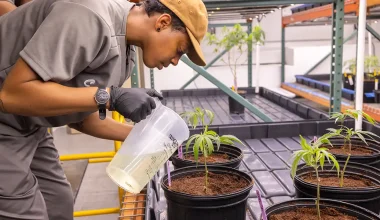(This is a contributed guest column. To be considered as an MJBizDaily guest columnist, please submit your request here.)

The cannabis industry is sitting on a ticking time bomb – one that’s been quietly growing for years while most operators look the other way.
Accounts receivable (AR) are ballooning to unsustainable levels, and beyond a few informal “blacklisted” groups on social media, no one is talking about the financial chokehold this is putting on the supply chain.
Right now, more than $2.24 billion in AR is circulating through the industry, based on data collected by CannaBiz Credit Association, a cannabis-specific credit reporting platform.
The problem has metastasized over the past four years, and while the bulk of outstanding AR sits mainly in three states, the data makes one thing clear: As markets mature and wholesale prices crash, delinquent payments surge.
Today, California leads the crisis with $777 million in reported AR, followed by Michigan ($231 million) and Massachusetts ($144 million).
Some states are seeing more than 30% of all receivables past due.
That’s a catastrophic rate in any industry, but it’s even more dangerous in one where liquidity already is razor thin.
At the core of this issue is the industry’s shift from cash-on-delivery transactions – standard in the legacy market – to offering payment terms without conducting proper credit checks.
In trying to move toward practices common in mainstream industries, cannabis businesses took one step forward but forgot the other.
The result? A broken system that allows businesses – sometimes in bad faith but often simply due to financial strain – to take on inventory they can’t afford with little consequence for slow-paying or outright defaulting.
Unpredictable cash flow for cannabis operators
When a company extends terms without proper vetting, it’s essentially issuing an unsecured loan – without any of the underwriting, collateral or risk assessment a bank would require.
Collection data confirms this is a dangerous gamble: It makes cash flow unpredictable and threatens businesses at every level, from cultivators and manufacturers to brands, tech providers and retailers.
To grasp how deep this crisis runs, let’s look at the aging patterns of these receivables.
While 46% of cannabis AR remains current (0-30 days), an alarming 24% – more than $529 million – has aged beyond 91 days.
The most concerning data point?
The 61- to 90-day delinquency bucket is only 5% of total AR, but once invoices hit 91-plus days, that number jumps to 24%.
This suggests a clear tipping point: If a company hasn’t paid within three months, the chances of ever seeing payment drop dramatically.
The longer invoices sit, less likely payments are made
Once an invoice ages beyond 60 days, the probability of collection plummets.
At 30 days past due, recovery rates remain relatively strong.
But at 90 days, the likelihood of collection falls below 50%. After two years, the probability of getting paid is less than 10%.
For any company, that kind of cash flow disruption is a death sentence.
When these aging receivables inevitably turn into write-offs, the financial fallout is far worse than most operators realize.
A business operating at a 25% net profit margin that writes off $10,000 needs to generate $40,000 in new revenue just to break even.
Why? Because only 25 cents of every dollar earned turns into profit – meaning it takes $4 in new sales to make up for every $1 lost.
With a $50,000 write-off, you’re looking at a $200,000 revenue gap.
In an industry where margins already are under extreme pressure, such losses don’t just sting, they kill companies.
Subscribe to the MJBiz Factbook
Exclusive industry data and analysis to help you make informed business decisions and avoid costly missteps. All the facts, none of the hype.
What you will get:
- Monthly and quarterly updates, with new data & insights
- Financial forecasts + capital investment trends
- State-by-state guide to regulations, taxes & market opportunities
- Annual survey of cannabis businesses
- Consumer insights
- And more!
How cannabis companies can avoid this trap
As more capital gets tied up in aging receivables, businesses have less cash available for growth, marketing, product innovation or even just keeping the lights on.
Many fall into the trap of extending even more credit in a desperate bid to drive revenue, which only deepens the crisis.
So, what’s the way out?
Start by implementing real credit-assessment procedures.
Companies using basic credit checks are 60% less likely to end up in collections.
A bank wouldn’t issue an unsecured, 0% interest loan without running due diligence; why should cannabis companies?
As the industry matures, the companies that embrace credit transparency and risk management will be the ones that survive.
Businesses must tighten payment terms, leverage data to assess risk and stop relying on handshake deals that expose them to catastrophic losses.
The warning signs are flashing red.
Operators who ignore them are gambling with their survival.
The choice is clear: Establish credit protocols now or prepare to write off far more than just a few bad debts.
Brett Gelfand is managing partner at CannaBiz Collects, based in St. Petersburg, Florida. He can be reached at brett@cannabizcollects.com.
To be considered for publication as a guest columnist, please submit your request here.
Medical Disclaimer:
The information provided in these blog posts is intended for general informational and educational purposes only. It is not a substitute for professional medical advice, diagnosis, or treatment. Always seek the advice of your physician or other qualified healthcare provider with any questions you may have regarding a medical condition. The use of any information provided in these blog posts is solely at your own risk. The authors and the website do not recommend or endorse any specific products, treatments, or procedures mentioned. Reliance on any information in these blog posts is solely at your own discretion.






